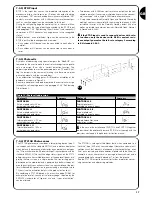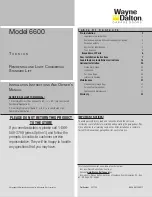
10
3.6) Description of the electrical connections
The following is a brief description of the electrical connections; for
further information please read “7.3 Adding or Removing Devices”
paragraph.
FLASH:
output for one or two “LUCYB” or similar type flashing lights
with single 12V maximum 21W bulb.
S.C.A.:
“Open Gate Indicator” output. An indicator lamp can be
connected (24V max. 4W). It can also be programmed for other
functions; see paragraph “7.2.3 Level two functions”
BLUEBUS:
compatible devices can be connected up to this termi-
nal. They are connected in parallel using two wires only, through
which both the electricity supply and the communication signals
travel. For more useful information about BlueBUS see also Para-
graph “7.3.1 BlueBUS”.
STOP:
input for the devices which block or eventually stop the
manoeuvre in progress. Contacts like “Normally Closed”, “Normally
Open” or constant resistance devices can be connected up using
special procedures on the input. For more useful information about
STOP see also Paragraph “7.3.2 STOP Input”.
STEP-BY-STEP:
input for devices which control Step-by-Step
movement. It is possible to connect “Normally Open” devices up to
this input.
OPEN:
input for devices which control only the opening movement.
It is possible to connect “Normally Open” devices up to this input.
CLOSE:
input for devices which control only the closing movement.
It is possible to connect “Normally Open” devices up to this input.
AERIAL:
connection input for the radio receiver aerial (the aerial is
incorporated in LUCY B).
The manufacturers recommend positioning the leaf at approximately mid-stroke before starting the checking and start up phase of the
automation. This will ensure the leaf is free to move both during opening and closure.
4) Final checks and start up
4.1) Choosing the direction
The direction of the opening manoeuvre must be chosen according
to the position of the gearmotor with respect to the leaf. If the leaf
must move to the left for opening, the selector must be moved
towards left as shown in Figure 17; alternatively, if the leaf has to
move to the right during opening, the selector must be moved
towards the right as shown in Figure 18.
17
18
4.2) Power supply connection
The connection of RUN to the mains must be made by
qualified and experienced personnel in possession of the
necessary requisites and in full observance of current
laws, provisions and standards.
As soon as RUN is powered up, check the following:
1.
Ensure that the “BLUEBUS” LED flashes regularly, with about one
flash per second.
2.
Ensure that the LED's on the photocells flash (both on TX and
RX); the type of flashing is not important as it depends on other
factors.
3.
Ensure that the flashing light connected to the FLASH output and
the lamp LED connected to the “Open Gate Indicator” output are
off.
If the above conditions are not satisfied, immediately switch off the
power supply to the control unit and check the electrical connections
more carefully. Please refer to Chapter “7.6 Troubleshooting” for fur-
ther information about fault-finding and analysis.
!
4.3) Device self-learning
After connecting up the power supply, the control unit must “learn” the devices connected up to the BLUEBUS and STOP inputs. Before this
phase, LEDs L1 and L2 will flash to indicate that device self-learning must be carried out.
The connected devices self-learning stage can be repeated at any time, even after the installation (for example, if a new device is installed);
to repeat self-learning see paragraph “7.3.6 Self-learning Other Devices”.
1.
Press and hold keys
[
▲
]
and
[Set]
2.
Release the keys when leds L1 and L2 start flashing very quickly (after approx. 3 s)
3.
Wait a few seconds for the control unit to finish self-learning the devices
4.
When the self-learning stage is complete, the STOP LED must remain on while L1 and L2 must turn
off (leds L3 and L4 will eventually start flashing).
19











































